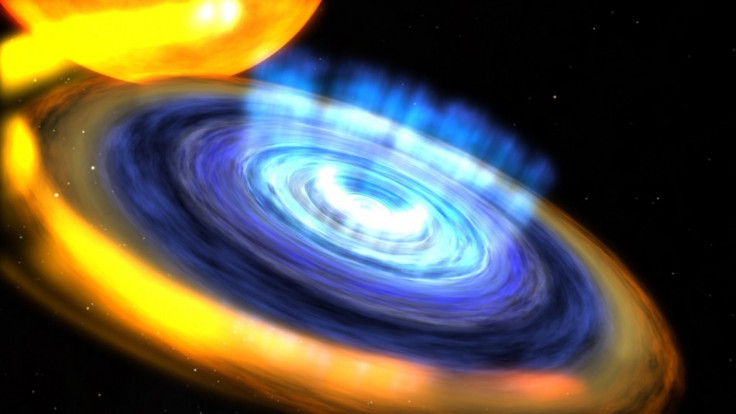Tiniest Black Hole Found
X-ray's From Distant System Closely Resemble a Heartbeat

One of NASA's hardest working space explorers has helped astrophysicists determine a series of X-ray bursts from a distant system may be the telltale heartbeat of the tiniest black hole ever found. A system called IGR J17091-3624 began emitting pulses of X-ray energy early in 2011, something it has periodically done since its discovery in 2003. The changes in X-ray energy from the system tend to swing back and forth not unlike a heartbeat, and this tells scientists how much matter around the black hole is getting sucked in. When matter from a nearby star, for example, falls into the black hole, it forms a heated disk of energy around the edge of the black hole.
As the black hole feeds on this energy, it expels jets of high-energy particles that NASA's Rossi X-ray Timing Explorer (RXTE) then detects. Those readings say the amount of energy being shot out by the black hole could only come from a very small black hole, in fact the smallest ever found.
"Just as the heart rate of a mouse is faster than an elephant's, the heartbeat signals from these black holes scale according to their masses," Diego Altamirano, an astrophysicist at the University of Amsterdam in The Netherlands said in a statement. Altamirano is also lead author of a paper describing the findings in the Nov. 4 issue of The Astrophysical Journal Letters.
The system is located near the constellation Scorpius, but its distance is not agreed on. It could be as close as 16,000 light-years or more than 65,000 light-years away. So far, only one other black hole has been found that emitted this X-ray heartbeat pattern, but it was much bigger than IGR J17091-3624. Called GRS 1915+105, this larger black hole is known to display more than a dozen highly structured patterns (heartbeats), typically lasting between seconds and hours.
"Until this study, GRS 1915 was essentially a one-off, and there's only so much we can understand from a single example," Tod Strohmayer, the project scientist for RXTE at NASA's Goddard Space Flight Center in Greenbelt, Md said in a statement.
"Now, with a second system exhibiting similar types of variability, we really can begin to test how well we understand what happens at the brink of a black hole."
Named IGR J17091-3624 after the astronomical coordinates of its sky position, the binary system combines a normal star with a black hole that may weigh less than three times the sun's mass. That is near the theoretical mass boundary where black holes become possible. Gas from the normal star streams toward the black hole and forms a disk around it. Friction within the disk heats the gas to millions of degrees, which is hot enough to emit X-rays. Cyclical variations in the intensity of the X-rays observed reflect processes taking place within the gas disk. Scientists think that the most rapid changes occur near the black hole's event horizon, the point beyond which nothing, not even light, can escape.
© Copyright IBTimes 2024. All rights reserved.





















